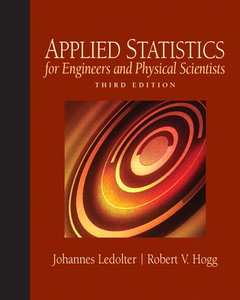Description
Applied statistics for engineers and physical scientists (3rd ed ) (3rd Ed.)
Authors: Ledolter Johannes, Hogg Robert
Language: English
Subject for Applied statistics for engineers and physical scientists...:
Approximative price 111.48 €
Subject to availability at the publisher.
Add to cart608 p. · 17.6x24 cm · Hardback
Description
/li>Contents
/li>Biography
/li>Comment
/li>
This hugely anticipated revision has held true to its core strengths, while bringing the book fully up to date with modern engineering statistics. Written by two leading statisticians, Statistics for Engineers and Physical Scientists,3/e, provides the necessary bridge between basic statistical theory and interesting applications. Readers solve the same problems that engineers and scientists face, and have the opportunity to analyze real data sets. Larger-scale projects are a unique feature of this book, which let readers analyze and interpret real data, while also encouraging them to conduct their own studies and compare approaches and results. This book assumes a calculus background. KEY TOPICS: Collection and Analysis of Information; Probability Models and Discrete Distributions; Continuous Probability Models; Statistical Inference: Sampling Distribution, Confidence Intervals, and Tests of Hypotheses; Statistical Process Control; Experiments with One Factor; Experiments with Two or More Factors; Regression Analysis. MARKET: For all readers interested in applied statistics.
Chapter 1: Collection and Analysis of Information
1.1 Introduction
1.1.1 Data Collection
1.1.2 Types of Data
1.1.3 The Study of Variability
1.1.4 Distributions
1.1.5 Importance of Variability (or Lack Thereof) for Quality and Productivity Improvement
1.2 Measurements Collected over Time
1.2.1 Time-Sequence Plots
1.2.2 Control Charts: A Special Case of Time-Sequence Plots
1.3 Data Display and Summary
1.3.1 Summary and Display of Measurement Data
1.3.2 Measures of Location
1.3.3 Measures of Variation
1.3.4 Exploratory Data Analysis: Stem-and-Leaf Displays and Box-and-Whisker Plots
1.3.5 Analysis of Categorical Data
1.4 Comparisons of Samples: The Importance of Stratification
1.4.1 Comparing Two Types of Wires
1.4.2 Comparing Lead Concentrations from Two Different Years
1.4.3 Number of Flaws for Three Different Products
1.4.4 Effects of Wind Direction on the Water Levels of Lake Neusiedl
1.5 Graphical Techniques, Correlation, and an Introduction to Least Squares
1.5.1 The Challenger Disaster
1.5.2 The Sample Correlations Coefficient as a Measure of Association in a Scatter Plot
1.5.3 Introduction to Least Squares
1.6 The Importance of Experimentation
1.6.1 Design of Experiments
1.6.2 Design of Experiments with Several Factors and the Determination of Optimum Conditions
1.7 Available Statistical Computer Software and the Visualization of Data
1.7.1 Computer Software
1.7.2 The Visualization of Data
Chapter 2: Probability Models and Discrete Distributions
2.1 Probability
2.1.1 The Laws of Probability
2.2 Conditional Probability and Independence
2.2.1 Conditional Probability
2.2.2 Independence
2.2.3 Bayes' Theorem
2.3 Random Variables and Expectations
2.3.1 Random Variables and Their Distributions
2.3.2 Expectations of Random Variables
2.4 The Binomial and Related Distributions
2.4.1 Bernoulli Trials
2.4.2 The Binomial Distribution
2.4.3 The Negative Binomial Distribution
2.4.4 The Hypergeometric Distribution
2.5...
Johannes Ledolter is a Professor of Statistics and Actuarial Sciences at the University of Iowa as well as a C. Maxwell Stanley Professor of International Operations Management at the Henry B. Tippie College of Business. Ledolter received his M.S. and Ph.D. degrees in Statistics from the University of Wisconsin-Madison along with an M.S degree in Social and Economic Statistics from the University of Vienna. His research interests are in time series analysis, forecasting, and applied statistical modeling. His publications have appeared in Biometrika, Technometrics, Communications in Statistics, and Management Science. He is the co-author of several books including Experimental Design with Applications in Marketing and Service Operations, Introduction to Regression Modeling, Statistical Quality Control, and Statistical Methods for Forecasting.
Robert V. Hogg, Professor Emeritus of Statistics at the University of Iowa since 2001, received his B.A. in mathematics at the University of Illinois and his M.S. and Ph.D. degrees in mathematics, specializing in actuarial sciences and statistics, from the University of Iowa. Known for his gift of humor and his passion for teaching, Hogg has had far-reaching influence in the field of statistics. Throughout his career, Hogg has played a major role in defining statistics as a unique academic field, and he almost literally "wrote the book" on the subject. He has written more than 70 research articles and co-authored four books including Introduction of Mathematical Statistics, 6th edition, with J. W. McKean and A.T. Craig, as well as Probability and Statistical
- The solid organization presents information in a logical, easy-to-grasp sequence and provides early discussion on fundamental statistical concepts such as data collection, variability, randomization, and graphical representation of data.
- Numerous exercises range from straightforward “drill” problems to more challenging problems that test conceptual understanding.
- Comprehensive coverage on the design of experiments (Chapters 6 and 7) and regression (Chapter 8) gives students abundant exposure to these topics.
- Thorough discussions include summarizing and interpreting data, basic probability and probability distributions, sampling distributions, and basic statistical inference.
- Data sets are available in Minitab® and text formats. They are available for download from the Pearson data sets website at www.pearsonhighered.com/datasets, or at www.biz.uiowa.edu/faculty/jledolter/AppliedStatistics.

